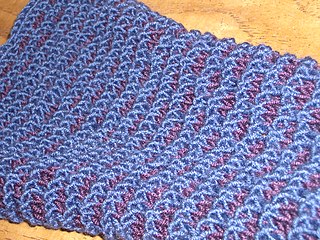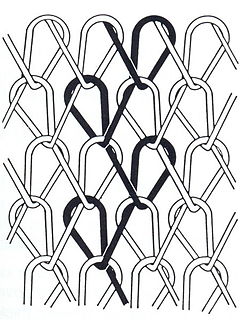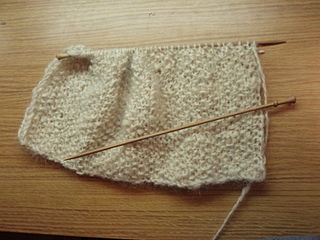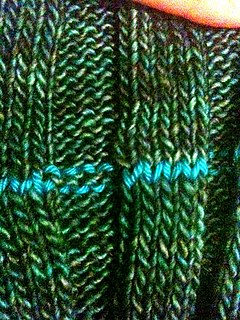
A knitting needle or knitting pin is a tool in hand-knitting to produce knitted fabrics. They generally have a long shaft and taper at their end, but they are not nearly as sharp as sewing needles. Their purpose is two-fold. The long shaft holds the active (unsecured) stitches of the fabric, to prevent them from unravelling, whereas the tapered ends are used to form new stitches. Most commonly, a new stitch is formed by inserting the tapered end through an active stitch, catching a loop of fresh yarn and drawing it through the stitch; this secures the initial stitch and forms a new active stitch in its place. In specialized forms of knitting the needle may be passed between active stitches being held on another needle, or indeed between/through inactive stitches that have been knit previously.

Nålebinding is a fabric creation technique predating both knitting and crochet. Also known in English as "knotless netting," "knotless knitting," or "single needle knitting," the technique is distinct from crochet in that it involves passing the full length of the working thread through each loop, unlike crochet where the work is formed only of loops, never involving the free end. It also differs from knitting in that lengths must be pieced together during the process of nålebinding, rather than a continuous strand of yarn that can easily be pulled out. Archaeological specimens of fabric made by nålebinding can be difficult to distinguish from knitted fabric.
English knitting, also known as right-hand knitting or throwing, is a style of Western knitting where the yarn to be knit into the fabric is carried in the right hand. This style is prevalent throughout the English-speaking world, though it is by no means universal.

A knitting machine is a device used to create knitted fabrics in a semi or fully automated fashion.

A decrease in knitting is a reduction in the number of stitches, usually accomplished by suspending the stitch to be decreased from another existing stitch or by knitting it together with another stitch.

Slip-stitch knitting is a family of knitting techniques that use slip stitches to make multiple fabrics simultaneously, to make extra-long stitches, and/or to carry over colors from an earlier row.
In knitting, an increase is the creation of one or more new stitches, which may be done by various methods that create distinctive effects in the fabric.

Drop-stitch knitting is a knitting technique for producing open, vertical stripes in a garment. The basic idea is to knit a solid fabric, then (deliberately) drop one or more stitches, producing a run in the fabric. The run will continue to the bottom edge of the garment, or until it encounters an increase, at which it stops.
In knitting, binding off, or casting off, is a family of techniques for ending a column of stitches. Binding off is typically used to define the final edge of a knitted fabric, although it may also be used in other contexts, e.g., in making button holes. In principle, binding off is the opposite of casting on, but the techniques are generally not mirror images of one another. Sometimes, however, they can produce a mirror image appearance.
Knitting abbreviations are often used for brevity in describing knitting patterns.

Beaded knitting is a type of knitting in which the stitches are decorated with ceramic or glass beads.

Warp knitting is a family of knitting methods in which the yarn zigzags along the length of the fabric; i.e., following adjacent columns, or wales, of knitting, rather than a single row, or course. For comparison, knitting across the width of the fabric is called weft knitting.

Flat knitting is a method for producing knitted fabrics in which the work is turned periodically, i.e., the fabric is worked with alternating sides facing the knitter. Another method of reaching the same result is to knit alternately from right to left and left to right without turning; this back-and-forth technique requires either innate or learned ambidextrous motor skills. The two sides of the fabric are usually designated as the right side and the wrong side.

In knitting, grafting is the joining of two knitted fabrics using yarn and a needle in one of three types of seams:
- selvage-to-selvage seam,
- selvage-to-end ("wales") seam, or
- end-to-end ("wale-to-wale") seam.

In knitting, picking up stitches means adding stitches to the knitting needle that were previously bound off or belong to the selvage.
In knitting, buttonholes can be made in several ways.

Double knitting is a form of hand knitting in which two fabrics are knitted simultaneously on one pair of needles. The fabrics may be inseparable, as in interlock knitted fabrics, or they can simply be two unconnected fabrics. In principle, an arbitrary number of fabrics can be knitted simultaneously on one pair of knitting needles with yarns, as long as one is careful.
Knitted fabric is a textile that results from knitting. Its properties are distinct from woven fabric in that it is more flexible and can be more readily constructed into smaller pieces, making it ideal for socks and hats.
Hand knitting is a form of knitting, in which the knitted fabric is produced by hand using needles.














